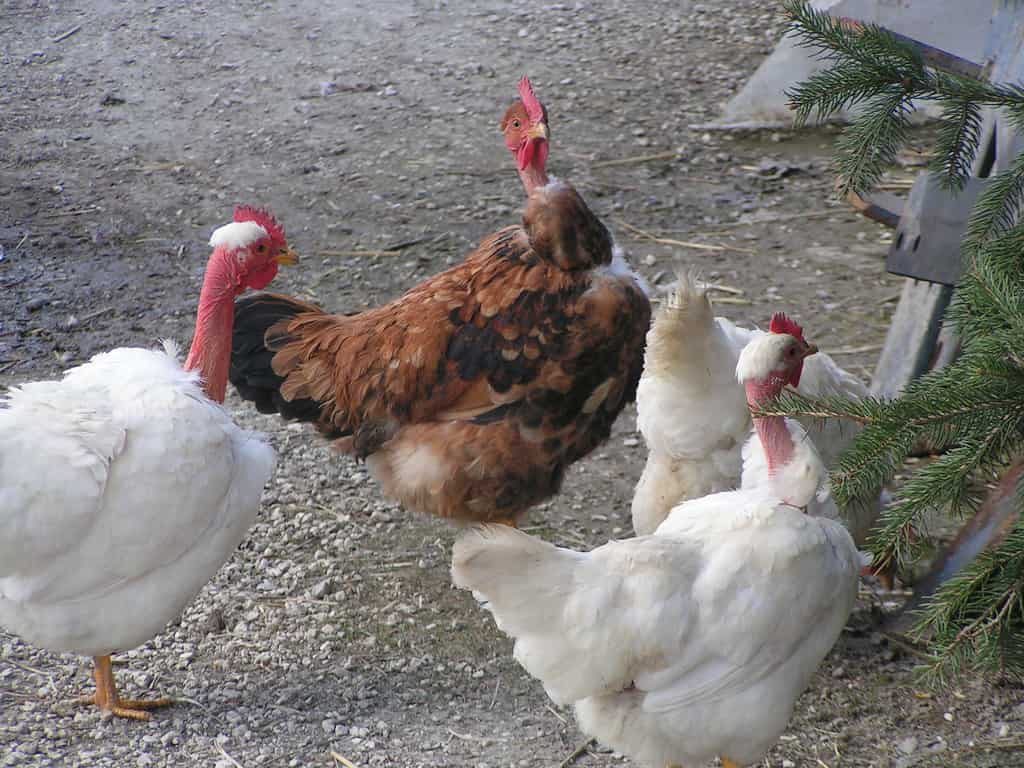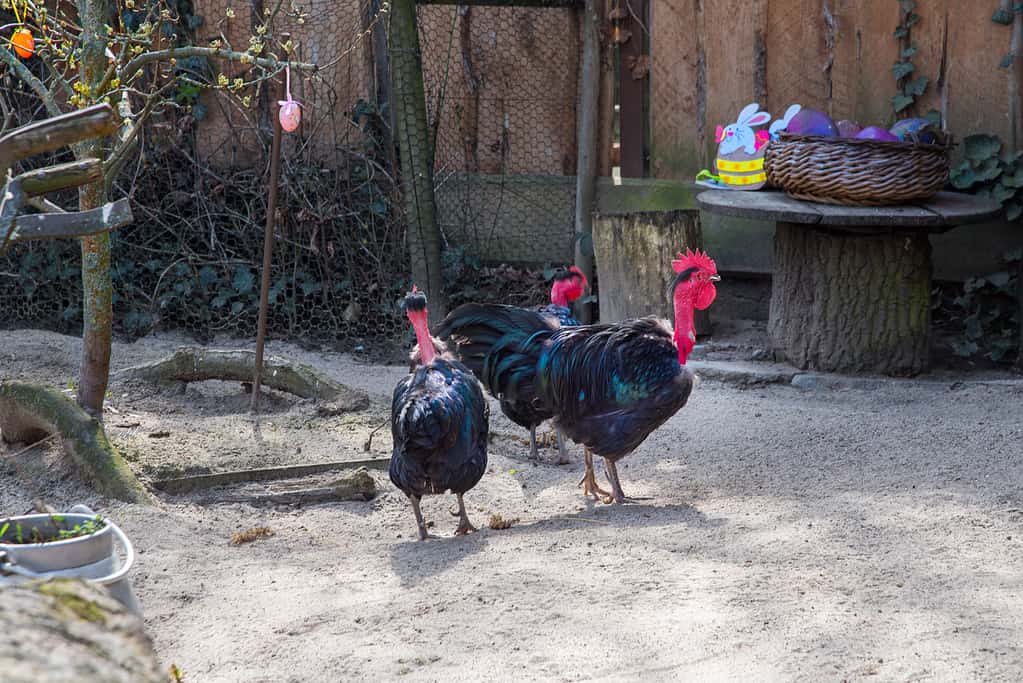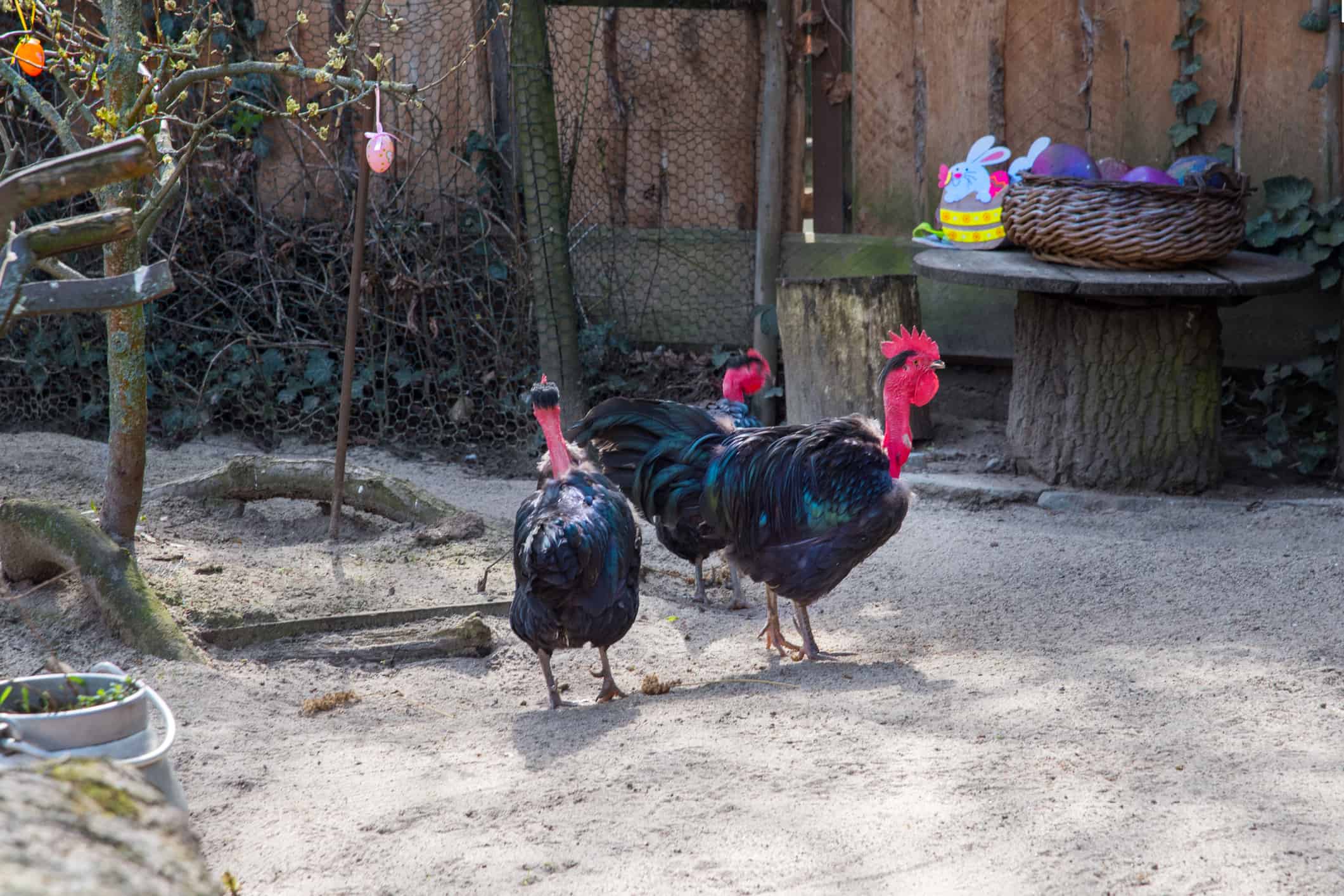Naked Neck chickens are among the most recognizable chicken breeds. Sometimes called a Turken, or Transylvanian Naked Neck, this odd-looking breed has no feathers on its neck. They have sparse feathers on the rest of their body, too, though that trait is easier to overlook. This breed tolerates the heat better than most others, and it gets along famously with both people and other chickens. Let’s learn more about this strange-looking chicken and what makes it so special.
Naked Neck Chicken Breed History

Naked neck chickens have bare necks and come in a variety of colors, including black, buff, red, and white.
©Jane Nadezhina/Shutterstock.com
The Naked Neck chicken is a dual-purpose breed that most likely originated in Asia. It arrived in Europe and the Middle East sometime during the 19th century. Sometimes called the Transylvania Naked Neck, named for the Transylvania region of modern-day Romania, where breeders worked to standardize the breed in the late 19th century. This breed grew in popularity in Germany and Austria in the early 1900s before exporters took it to countries around the world.
The Naked Neck chicken is sometimes called a Turken. Some people even believe that the Naked Neck is a hybrid cross between a turkey and a chicken, but that is not true. Naked Neck chickens belong to the same species as other domestic chickens, Gallus gallus domesticus.
Characteristics

Naked Neck chickens have sparse feathers on the rest of their body.
The trademark featherless neck of the Naked Neck chicken comes from a single mutated gene. The gene is incompletely dominant, meaning that chickens that have two copies of the gene, or homozygous dominant, have fully featherless necks. Even young chicks with two copies of the gene have bare necks. Homozygous dominant individuals breed true.
Chickens with only one copy of the gene, or heterozygous, have partially feathered necks. These birds do not breed true. When breeding two heterozygous Naked Neck chickens, some offspring will have naked necks, some will have partially feathered necks, and some will have feathered necks. Meanwhile chickens without the gene, or homozygous recessive, have normal feathering.
The gene that gives Naked Neck chickens their bare neck also causes them to have fewer feathers all over their body than other chicken breeds. Homozygous dominant individuals may have as little as 40 to 50 percent of the feathers of chickens without the gene. Their sparse feathers may not be easy to see from a distance, but when handled the trait becomes obvious.
Color Patterns
The American Poultry Association recognizes four colors of full-size Naked Neck chickens, including black, white, buff, and red. They recognize only white, buff, and red in bantam sizes. In the United Kingdom, standard colors include black, white, buff, red, cuckoo, and blue.
Other Features
Naked Neck chickens have large bodies with well-rounded breasts and broad backs. Roosters have long tails with curved sickle feathers that they hold somewhat erect. They have yellow skin, but the skin on their bare necks turns bright red from exposure to the sun. They have a red single comb with points, medium red wattles, and red earlobes. Most members of this breed have yellow beaks and shanks with clean, featherless feet with four toes.
Temperament
Owners say that Naked Neck chickens are extremely friendly and docile. These chickens love spending time with people. They do especially well with children. These birds mix well with other breeds and get along just fine with most other chickens. Even the roosters behave in a friendly manner, although some show aggressive tendencies. Owners say that this breed is exceptionally smart, and can escape from enclosures that other birds cannot.
Naked Neck Chicken Eggs
The Naked Neck chicken lays about 3 to 4, medium to large eggs per week, averaging about 150 to 200 eggs per year. They reportedly produce more reliably in the warm months than in the cold. These birds are among the chicken breeds that lay brown eggs.
Hens of this breed do tend to go broody. If allowed to hatch their eggs, they also make good and attentive mothers. Owners may need to reduce the number of eggs in a Naked Neck hen’s clutch, though. Because of her sparse feathers, she may not be able to adequately incubate as many eggs as most other breeds.
Meat Production

Naked Neck chickens are dual-purpose birds that produce high-quality meat.
©NataliaVo/iStock via Getty Images
Naked Neck chickens, as a dual-purpose breed, make excellent meat birds. They don’t slow down in their growth during the summer because they have no trouble tolerating the heat. They average 8.5 pounds for males and 6.5 pounds for hens when fully grown. The gene associated with the breed’s bare neck also produces a large and meaty breast. Owners say that the Naked Neck chicken has tender, juicy, and very flavorful meat with a low-fat content. Perhaps the best part about Naked Neck chickens is how easy they are to pluck. With such sparse feathers, plucking and cleaning the birds takes very little time.
Naked Neck Prices
As of this writing, in the fall of 2023, Naked Neck chicks from hatcheries in the United States average between about $4.50 and $6.00 each. Most hatcheries offer discounts on bulk orders.
Thank you for reading! Have some feedback for us? Contact the AZ Animals editorial team.








